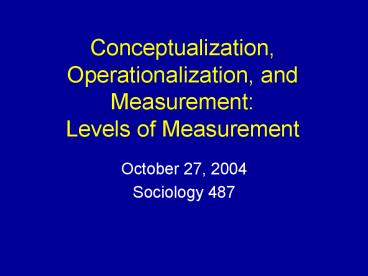Conceptualization, Operationalization, and Measurement: Levels of Measurement - PowerPoint PPT Presentation
1 / 12
Title:
Conceptualization, Operationalization, and Measurement: Levels of Measurement
Description:
Few true interval measures in social sciences. One example: Scores on standardized intelligence tests ... composing a variable are based on a true zero point ... – PowerPoint PPT presentation
Number of Views:250
Avg rating:3.0/5.0
Title: Conceptualization, Operationalization, and Measurement: Levels of Measurement
1
Conceptualization, Operationalization, and
MeasurementLevels of Measurement
- October 27, 2004
- Sociology 487
2
Lecture Topics
- Levels of Measurement
- Nominal
- Ordinal
- Interval
- Ratio
- Dichotomous Variables
3
From Operationalization to Levels of Measurement
- The mathematical precision with which the values
of a variable can be expressed is the level of
measurement - The nominal level of measurement is qualitative
- It has no mathematical interpretation
- Ordinal, interval, and ratio levels of
measurement are quantitative - They are progressively more precise mathematically
4
Nominal Measures
- Identifies variables whose values have no
mathematical interpretation - Variables vary in kind or quality but not in
amount.
In terms of the variable Dog Breed, you can say
that the German Shepherd is not equal to the
Terrier, but you cannot say that the German
Shepherd is dog breedier or less dog breedy
than the Terrier.
5
Ordinal Measures
- Variables with attributes we can logically rank
and order - Specify only the order of cases
- Greater than and less than distinctions
- Nothing is specified in terms of actual numbers
6
Interval Measures
- Distances separating variables
- Numbers represent fixed measurement units BUT
have no absolute zero point - Few true interval measures in social sciences
- One example Scores on standardized intelligence
tests - Why is it incorrect to state that someone with an
IQ of 150 is 50 more intelligent than someone
with an IQ of 100?
7
Ratio Measures
- Attributes composing a variable are based on a
true zero point - Zero represents none of the variable
- Ratio measures can be added and subtracted, and
multiplied and divided - Example age
- 10 is 2 years older than 8 and 2 times greater
than 5
8
Dichotomies
- Variables having only two values
- Gender Female / Male
- Marital Status Married / Not Married
- Employment Status Employed / Not Employed
- Dichotomies indicate presence or absence of
attribute - Categorical but with inherent order
- What is the level of measurement of dichotomous
variables?
9
Comparison of Levels of Measurement
10
You Decide Level of Measurement
- Level of measurement is not inherent in variables
- Age
- Nominal Age 65 and over (yes / no)
- Ordinal Young, Middle-Aged, Old
- Ratio Years of age
11
Operationalization Choices
- Questions to consider when determining level of
measurement - What is the range of variation required?
- What analytical uses are planned for the
variables? - General guidelines
- Collect more information instead of less
information - Ratio measures can be converted into ordinal but
ordinal can not be converted into ratio
12
Key Points
- Levels of measurement provide a framework for
interpreting categories of a variable - Nominal measures are qualitative
- Ordinal, interval, and ratio are quantitative
- Levels of measurement are not inherent in
variables - Selected based on research question and analysis
plans































